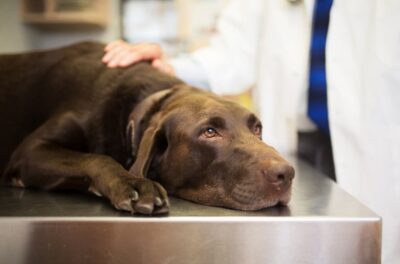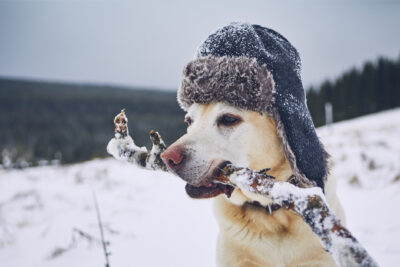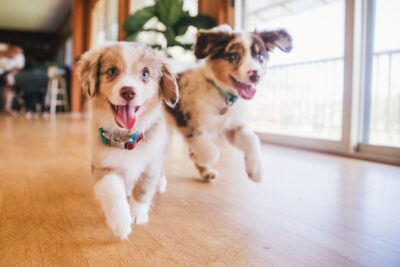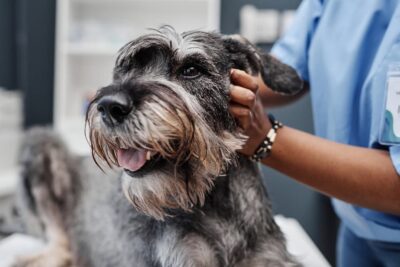GOLPP in Dogs (Laryngeal Paralysis)

Overview
Aging dogs are more likely to develop chronic health conditions. For large and giant breed dogs, one of the common conditions pet parents may have to contend with is a neurologic condition called GOLPP. Find out what GOLPP in dogs is and how it’s managed.
What Is GOLPP in Dogs?

GOLPP stands for Geriatric Onset Laryngeal Paralysis and Polyneuropathy. GOLPP is a neurologic condition affecting older dogs that involves the slow degeneration of long nerves in the body. Over time, the nerve degeneration leads to loss of nerve function. Most commonly, changes are noticed in the larynx (voice box), esophagus, and back legs.
The recurrent laryngeal nerves are some of the longest nerves in the dog’s body. These nerves affect the ability of the larynx to open and close when the dog breathes. As a result, dogs with GOLPP develop a condition called laryngeal paralysis where their larynx doesn’t open fully when they breathe air in. Laryngeal paralysis in dogs is often the first sign that’s noticed with GOLPP. The nerves in the esophagus are also commonly affected, causing difficulty swallowing food and water.
The sciatic nerve is another long nerve in the body, which runs down the back legs. This nerve is often affected as well, resulting in hind end weakness and loss of muscle mass. Over time, other nerves are affected, causing generalized weakness.
Causes of GOLPP
GOLPP in dogs is most common in medium-to-large, geriatric dogs with an average onset of 11 years of age. Labrador Retrievers are the most commonly affected dog breed.
Although the underlying cause of GOLPP isn’t well understood, the fact that some breeds are predisposed implies that genetics play a role.
GOLPP in Dogs Symptoms

GOLPP often starts with symptoms of laryngeal paralysis in dogs, and then progresses to loss of nerve function in the limbs and difficulty swallowing.
The signs of GOLPP include:
- Noisy breathing (stridor), which sometimes sounds raspy
- Coughing and gagging
- Regurgitating food and water
- Exercise and heat intolerance
- Excessive panting
- Changes to how the dog’s bark sounds (sometimes sounds hoarse)
- Hind end weakness, causing difficulty rising or pushing off the back legs
- Loss of muscle mass, especially in the hind end
- Collapse
GOLPP doesn’t have specific stages, but the signs of laryngeal paralysis are usually noticed first, meaning noisy breathing, excessive panting, gagging, and bark changes. Pet parents should seek veterinary evaluation if they’re noticing these early signs of GOLPP in their dog.
Dogs with laryngeal paralysis and difficulty swallowing have an increased risk of accidentally inhaling water, food, or vomitus. These dogs can develop aspiration pneumonia, which can cause coughing, difficulty breathing, fever, vomiting, and lethargy.
GOLPP Dog Diagnosis
The laryngeal paralysis part of GOLPP is diagnosed with a sedated laryngeal exam. During this procedure, the dog is sedated, and the veterinarian looks into the dog’s mouth with a light to examine the larynx. The veterinarian will be able to see if the larynx opens appropriately when the dog inhales.
There is no single test to definitively diagnose GOLPP. The overall diagnosis of GOLPP is usually made when a dog with laryngeal paralysis has progressive loss of neurological function, such as becoming weak in the hind end.
Your veterinarian may also recommend additional testing to rule out other causes of your dog’s symptoms. These tests may include: bloodwork (CBC/chemistry profile), radiographs of the neck and hind legs, and nerve and muscle biopsies.
GOLPP Dog Treatment & Management

Many dogs with mild signs of GOLPP live their lives without any treatment. For dogs who do require intervention, it’s more about ongoing management rather than actual treatment. The exception to this is dogs who undergo laryngeal surgery.
Dogs who have laryngeal paralysis that is affecting their breathing significantly may benefit from a surgery called a laryngeal tie-back. The larynx is opened during the surgery, which allows the dog to breathe more effectively.
Dogs who have trouble swallowing may need to be fed in an upright position (such as in a Bailey chair) to reduce the risk of aspiration of food. If your veterinarian recommends using a Bailey chair, make sure to follow their instructions regarding how long your dog needs to remain upright after eating. If a dog with GOLPP develops aspiration pneumonia, they may need to be hospitalized for treatment and monitoring.
Dogs with GOLPP may also benefit from physical therapy to maintain muscle mass. Other things you can do to help your pet include reducing stress, using anti-anxiety medications, limiting exercise and exposure to hot weather, using a harness rather than a collar around the neck, and keeping your pet at a healthy weight.
Cost
The cost of the laryngeal tie-back procedure could range from $3,000 to $6,000. Dogs who have respiratory difficulty or develop aspiration pneumonia may have increased costs.
Prognosis
GOLPP is not currently curable. The symptoms of GOLPP in dogs will progressively worsen over time. Luckily, the condition is usually slowly progressive. Some dogs will have only mild signs of laryngeal paralysis for years and live a normal lifespan, passing away from an unrelated condition.
If breathing is seriously affected by laryngeal paralysis, laryngeal tie-back surgery may be necessary to improve quality of life.
For dogs who develop the condition when they’re a bit younger or who experience more rapid progression, euthanasia may need to be considered when the condition progresses to severely impact breathing or mobility. Dogs with recurrent episodes of aspiration pneumonia will also have a poorer prognosis.
Ongoing Monitoring

Pet parents will want to monitor their dogs for breathing difficulties, especially after exercise or in the heat. As GOLPP progresses, they may begin to notice hind end weakness and/or difficulty swallowing. If your dog is coughing when eating or drinking, it’s a good idea to speak with a veterinarian.
Signs of aspiration pneumonia to be on the lookout for include coughing, lethargy, loss of appetite, and vomiting.
It is best to avoid strenuous activity and prolonged exposure to heat, as these may exacerbate a dog’s difficulty breathing. In some cases, respiratory distress that requires emergent care can develop.
The progression of GOLPP is often unique to the individual dog. It’s best to work closely with a veterinarian to develop a management and monitoring plan specific to your pet.









